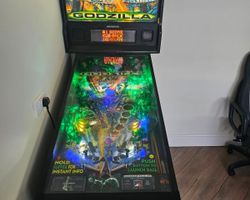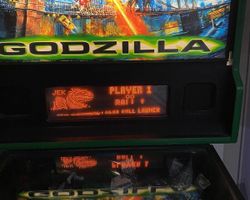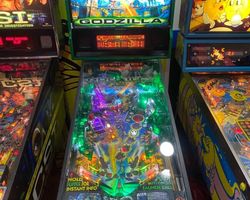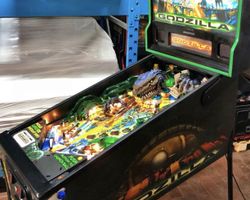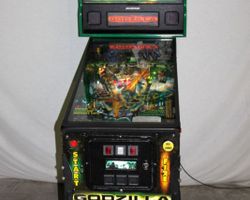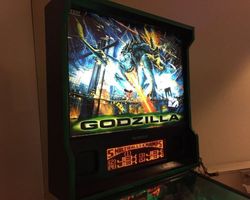Godzilla
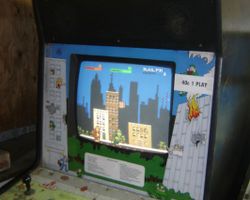
Average Prices: USD $1,100 to $2,800
Produced: August, 1998
Machine Type: Solid State Electronic
MPU: Sega/Stern Whitestar
Players: 6
Design by: Joe Balcer
Art by: Morgan Weistling
Software by: Neil Falconer, Orin Day
Sega Pinball, Incorporated's "Godzilla" machine, released in August 1998, plunges players into the colossal conflict against the iconic monster. Based on the 1998 film, this solid-state electronic (SS) pinball machine, model number 40, was a significant release for Sega Pinball during the peak of its operations. The game's inception stemmed from a desire to capitalize on the widespread appeal of the Godzilla franchise, bringing the kaiju's destructive power to the pinball playfield.
The development of "Godzilla" involved a dedicated team of designers and artists. Joe Balcer and Joe Kaminkow were instrumental in the game’s overall design, shaping its core mechanics and flow. The distinct visual identity of the machine was crafted by artists Greg Pro and Morgan Weistling, who infused the playfield and backglass with a dark, atmospheric aesthetic, reminiscent of a city under siege. Dave Link, founder of Evolution Studio, contributed a crucial element: the prominent Godzilla head sculpture that dominates the playfield. The auditory landscape was composed by Kyle Johnson, responsible for both the music and sound effects, aiming to immerse players in the monster's world. Software engineers Neil Falconer and Orin Day translated the design into code, while Kurt Andersen brought the animations to life on the dot matrix display. Produced in a limited run of 510 units, "Godzilla" debuted with an MSRP of $2600. Despite its relatively small production, it garnered attention for its thematic integration and unique features, becoming a recognizable title within Sega Pinball's Whitestar generation of machines.
Signature Features and Design
"Godzilla" distinguishes itself with several standout features that directly engage with its theme. The most striking is the sculpted Godzilla head toy, a central figure on the playfield. More than just an aesthetic piece, this head incorporates a ball diverter mechanism: shots routed through Godzilla’s mouth result in the ball exiting through a different, unpredictable path, creating dynamic and thrilling gameplay moments. Further enhancing the sense of a city under attack are four powerful electromagnets embedded beneath the playfield, particularly the "Radioactive Breath" magnet positioned in front of the Godzilla head. These magnets unpredictably alter ball trajectory, adding an element of chaos and challenge, simulating the monster's disruptive force.
The immersive experience is further amplified by a shaker motor integrated into the cabinet. This motor provides tactile feedback, rumbling and vibrating the machine during specific events, such as multiball modes or particularly intense shot sequences, enhancing the feeling of a destructive presence. Aesthetically, the artwork by Greg Pro and Morgan Weistling employs a palette dominated by dark tones and vibrant greens, creating a stormy, apocalyptic atmosphere. The green ramps are particularly notable, standing out against the darker backdrop and drawing the player’s eye towards key shots. The overall visual design, combined with the physical feedback from the shaker and the magnetic playfield effects, ensures that "Godzilla" offers a captivating and physically engaging pinball experience.
Playfield and Mechanics
The playfield of "Godzilla" is designed around a direct and fast-paced gameplay philosophy, featuring a layout that encourages rapid ball movement and strategic shot selection. The layout includes two prominent ramps, essential for shot progression and scoring. Three pop bumpers located near the top of the playfield provide lively action and contribute to chaotic ball movement, feeding into various targets and lanes. The game features two standard flippers at the bottom, providing precise control over shots. Three captive balls offer targets for skill shots and mode activation, while two spinners add to the scoring potential with rapid rotations. The automatic plunger ensures consistent skill shot launches, and four multiball opportunities keep the action intense.
The flow of the game emphasizes hitting long ramp shots and engaging the interactive Godzilla head. Players must master timing to send balls into the monster's mouth or activate the magnets that guard its approach. The artwork adorning the playfield continues the dark, rainy, and urban destruction theme, effectively conveying the presence of the monstrous creature. The green ramps are a visual focal point, contrasting with the dark cityscape imagery and further enhancing the thematic coherence. While some players find the shot variety sufficient, others have noted a focus on repetitive shots, particularly those leading to multiball. The lighting, though contributing to the moody aesthetic, can be perceived as dark by some, making ball tracking challenging in certain areas of the playfield.
Gameplay Dynamics
"Godzilla" focuses heavily on its multiball mechanics, a core element of its scoring system and progression. The primary objective often revolves around activating and stacking multiple multiballs simultaneously to maximize points and create a chaotic, high-energy environment. The game features four distinct multiball modes, each requiring specific shot sequences or target completions to initiate. Once multiball is achieved, the challenge shifts to managing multiple balls on the playfield while aiming for high-value targets, often the ramps or the Godzilla head.
Beyond the multiball focus, "Godzilla" incorporates unique modes and objectives, such as "Save New York," a mini-wizard mode that provides a thematic goal to work towards. Player strategies often involve prioritizing the completion of modes that lead to multiball activation, then skillfully navigating the ensuing chaos to make the most of the limited ball time. For instance, hitting specific targets or ramps during multiball might light additional features or increase scoring multipliers. The progression is straightforward: build towards multiball, stack them for amplified scoring, and then try to complete the "Save New York" objective. While this emphasis on multiball creates exciting and often visually impressive sequences with multiple balls in play and the shaker motor active, some players have found the primary goal of stacking multiballs to be somewhat repetitive over extended play sessions. The custom speech callouts, while thematic, are often cited as a point of contention among players due to their repetitive nature.
Reception and Legacy
The reception of "Godzilla" within the pinball community has been notably mixed, yet generally leans positive, contributing to its unique legacy. Its strengths are frequently highlighted, particularly the visual aspects. The Godzilla head sculpture is consistently praised for its striking presence and interactive nature, as is the overall playfield and backglass artwork, with its distinctive dark and green aesthetic capturing the film's atmosphere effectively. Many players appreciate the fast-paced gameplay and the inherent challenge of stacking multiple multiballs, finding this aspect to be both engaging and a source of high scores. The inclusion of physical features like the shaker motor and the playfield magnets is often cited as a positive, enhancing the tactile and dynamic feel of the game. Due to its limited production run of 510 units, "Godzilla" has developed a reputation for rarity and collectibility, making it a sought-after machine for some enthusiasts.
However, "Godzilla" is not without its criticisms. A common point of feedback revolves around the perceived lack of gameplay depth, with some players finding the ruleset to be too simplistic and the heavy reliance on multiball modes leading to repetitive play sessions. The shot repetition, particularly concerning the main ramps, is another area frequently mentioned. The audio package, including sound effects and callouts, has received considerable criticism for being repetitive and sometimes lacking energy or becoming annoying over time. Additionally, some players have noted that the playfield lighting can be too dark, impacting visibility and ball tracking, and there have been isolated concerns regarding the general build quality associated with Sega machines of this era.
Despite these critiques, "Godzilla" maintains a solid, if sometimes debated, reputation. It is often regarded as an underrated machine by some, who appreciate its direct approach and thematic execution, while others find its less complex ruleset to be a drawback. Its significance lies in being a prominent licensed title from Sega Pinball's Whitestar era, demonstrating the manufacturer's approach to integrating cinematic themes with pinball mechanics. The machine's rarity ensures its continued presence in collections, and it serves as a distinct example of late 1990s pinball design, occupying a unique space in the larger history of the hobby.
Sponsored Links
 Ebay Listings
Ebay Listings
 Auction Results
Auction Results
| Cost | Location | Date |
|---|---|---|
| GBP £7,187 |  Stoke Poges, United Kingdom Stoke Poges, United Kingdom |
29 September, 2025 |
| GBP £4,750 |  United Kingdom United Kingdom |
07 January, 2024 |
| GBP £3,250 |  Bognor Regis, United Kingdom Bognor Regis, United Kingdom |
20 December, 2022 |
| USD $4,300 |  Pennsylvania, United States Pennsylvania, United States |
17 May, 2020 |
| USD $3,850 |  Ohio, United States Ohio, United States |
03 April, 2019 |
| GBP £2,699 |  Czech Republic Czech Republic |
23 November, 2018 |
| USD $2,700 |  Pennsylvania, United States Pennsylvania, United States |
10 February, 2017 |
| USD $1,675 |  Tennessee, United States Tennessee, United States |
29 October, 2016 |
| EUR €3,299 |  Nordrhein-Westfalen, Germany Nordrhein-Westfalen, Germany |
02 August, 2016 |
| GBP £2,000 |  Weston-super-mare, United Kingdom Weston-super-mare, United Kingdom |
06 December, 2015 |


Private Policy · Search Website · Contact Us
As an eBay Partner, we may earn a commission from qualifying purchases made through links on this site, at no additional cost to you.
All trademarks and copyrighted materials remain property of their respective owners. All other content copyright 2007 - 2025 Pinpedia.

